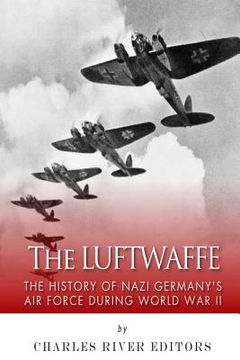The Luftwaffe: The History of Nazi Germany's Air Force during World War II (in English)
Synopsis "The Luftwaffe: The History of Nazi Germany's Air Force during World War II (in English)"
*Includes pictures *Includes accounts of fighting between the Luftwaffe and the Allies *Includes online resources and a bibliography for further reading *Includes a table of contents "My Luftwaffe is invincible...And so now we turn to England. How long will this one last - two, three weeks?" - Hermann Goering, June 1940 The Third Reich's Luftwaffe began World War II with significant advantages over other European air forces, playing a critical role in the German war machine's swift, powerful advance. By war's end, however, the Luftwaffe had been decimated by combat losses and crippled by poor decisions at the highest levels of military decision-making, and it proved unable to challenge Allied air superiority despite a last-minute upsurge in German aircraft production. Given its unique strengths and distinctive weaknesses by the personal quirks of the men who developed it, the Luftwaffe initially overwhelmed the more conservative, outdated military aviation of other countries. Its leaders embraced such concepts as the dive-bomber, which proved both utterly devastating and extremely useful for supporting the sweeping, powerful movements of Blitzkrieg, while other martial establishments rejected dive-bombers as impractical or even impossible. Though the superb fighting qualities of highly trained and motivated German soldiers, and the Third Reich's technological superiority in tank and weapon design, also had crucial roles to play, the Luftwaffe represented the key element making the successes of all other branches possible. While the Luftwaffe enjoyed air superiority, the combat fortunes of the Third Reich continued to ride high. When control of the air passed decisively to the Allies, Germany's hopes of victory began accelerating into a spiral of defeat. Early in the war, prowling masses of Luftwaffe aircraft fatally hampered the attempts of hostile forces to maneuver. The omnipresent Stuka dive-bombers crisscrossing the skies pounced on any infantry or vehicles incautious enough to emerge from hiding during the day, except in foul weather that kept the airplanes grounded. The German forces, meanwhile, moved freely and rapidly, surrounding or bypassing their enemies again and again and thus compelling their surrender. The Luftwaffe's eventual loss of aerial domination exposed the Germans to precisely the same misfortunes on the ground as they had once relentlessly inflicted on the Poles and Russians. In the Falaise Pocket in Normandy, for example, the splendidly lethal Panthers, Tigers, and Tiger II tanks of the Nazi Panzer Divisions never had the opportunity to destroy the flimsily-armored, outgunned Sherman tanks of their American opponents. Instead, American fighter-bombers systematically annihilated them and their supporting infantry formations from the air, leaving the landscape strewn with flipped-over tank hulks and in places literally carpeted with the flesh of dead men. Some 10,000 Germans died and 50,000 surrendered to the western Allies at Falaise, due to Hitler's order to counterattack without air support. During its heyday, however, the Luftwaffe amply proved the leading role played by air power in the modern combined arms formula. It also produced a remarkable number of aces, whose exploits overshadowed the finest pilots of the Soviet Union, the United Kingdom, or the United States. The Luftwaffe: The History of Nazi Germany's Air Force during World War II looks at the role the German air force played during the war, from its origins to its near demise. Along with pictures of important people, places, and events, you will learn about the Luftwaffe like never before, in no time at all.

